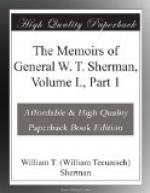While we were surveying at “New York of the Pacific,” occurred one of those little events that showed the force of the gold-fever. We had a sailor-boy with us, about seventeen years old, who cooked our meals and helped work the boat. Onshore, we had the sail spread so as to shelter us against the wind and dew. One morning I awoke about daylight, and looked out to see if our sailor-boy was at work getting breakfast; but he was not at the fire at all. Getting up, I discovered that he had converted a tule-bolsa into a sail boat, and was sailing for the gold-mines. He was astride this bolsa, with a small parcel of bread and meat done up in a piece of cloth; another piece of cloth, such as we used for making our signal-stations, he had fixed into a sail; and with a paddle he was directing his precarious craft right out into the broad bay, to follow the general direction of the schooners and boats that he knew were ascending the Sacramento River. He was about a hundred yards from the shore. I jerked up my gun, and hailed him to come back. After a moment’s hesitation, he let go his sheet and began to paddle back. This bolsa was nothing but a bundle of tule, or bullrush, bound together with grass-ropes in the shape of a cigar, about ten feet long and about two feet through the butt. With these the California Indiana cross streams of considerable size. When he came ashore, I gave him a good overhauling for attempting to desert, and put him to work getting breakfast. In due time we returned him to his ship, the Ohio. Subsequently, I made a bargain with Mr. Hartnell to survey his ranch at Cosnmnes River, Sacramento Valley. Ord and a young citizen, named Seton, were associated with me in this. I bought of Rodman M. Price a surveyor’s compass, chain, etc., and, in San Francisco, a small wagon and harness. Availing ourselves of a schooner, chartered to carry Major Miller and two companies of the Second Infantry from San Francisco to Stockton, we got up to our destination at little




